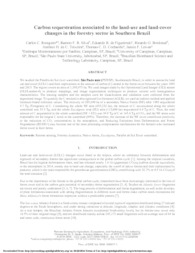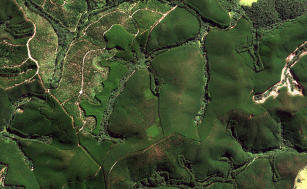Carbon sequestration associated to the land-use and land-cover changes in the forestry sector in Southern Brazil.
Carbon sequestration associated to the land-use and land-cover changes in the forestry sector in Southern Brazil.
Author(s): RONQUIM, C. C.; SILVA, R. F. B.; FIGUEIREDO, E. B. de; BORDONA, R. O.
Summary: We studied the Paraíba do Sul river watershed , São Paulo state (PSWSP), Southeastern Brazil, in order to assess the land use and cover (LULC) and their implication s to the amount of carbon (C) stored in the forest cover between the years 1985 and 2015. Th e region covers a n area of 1,395,975 ha . We used images made by the Operational Land Imager (OLI) sensor (OLI/Landsat - 8) to produce mappings , and image segmentation techniques to produce vectors with homogeneous characteristics. The training samples and the samples used for classification and validation were collected from the segmented image. To quantify the C stocked in aboveground live biomass (AGLB) , we used an indirect method and applied literature - based reference values. The recovery of 205,690 ha of a secondary Native Forest (NF) after 1985 sequestered 9.7 Tg (Teragram) of C . Considering the whole NF area (455,232 ha), the amount of C accumulated al ong the whole watershed was 3 5 .5 Tg , and the whole Eucalyptus crop (EU) area (113,600 ha) sequester ed 4. 4 Tg of C. Thus, the total amount of C sequestered in the whole watershed (NF + EU) was 3 9 . 9 Tg of C or 1 45 . 6 Tg of CO 2 , and the NF areas were responsible for the large st C stock at the watershed (8 9 %). Therefore , the increase of the NF cover contribut es positively to the reduction of CO 2 concentration in the atmosphere, and Reducing Emissions from Deforestation and Forest Degradation (REDD + ) may become one of the most promising compensation mechanisms for the farmers who increased forest cover at their farms.
Publication year: 2016
Types of publication: Journal article
Unit: Embrapa Territorial
Observation
Some of Embrapa's publications are published as ePub files. To read them, use or download one of the following free software options to your computer or mobile device. Android: Google Play Books; IOS: iBooks; Windows and Linux: Calibre.
Access other publications
Access the Agricultural Research Database (BDPA) to consult Embrapa's full library collection and records.
Visit Embrapa Bookstore to purchase books and other publications sold by Embrapa.


